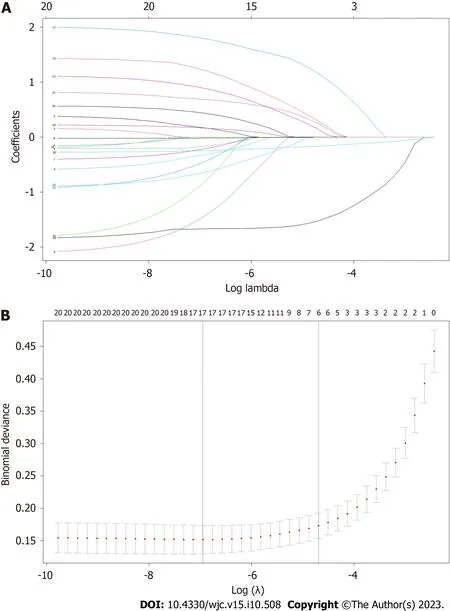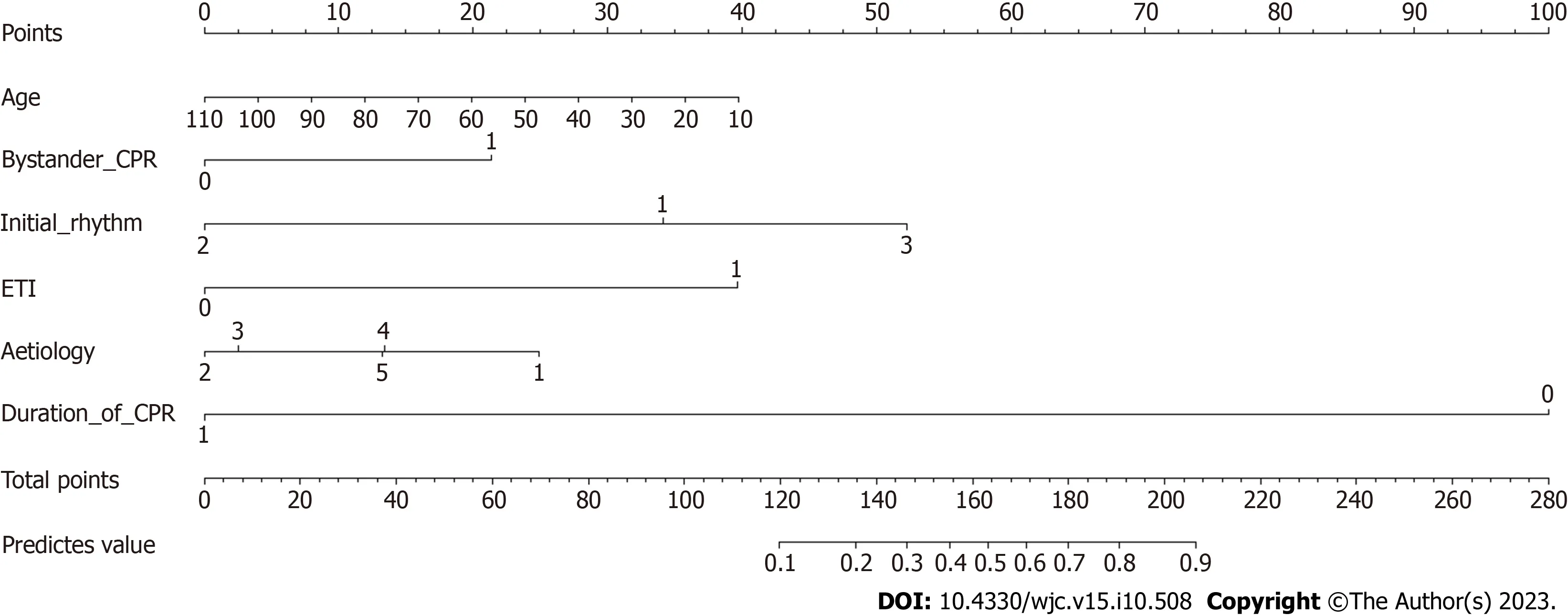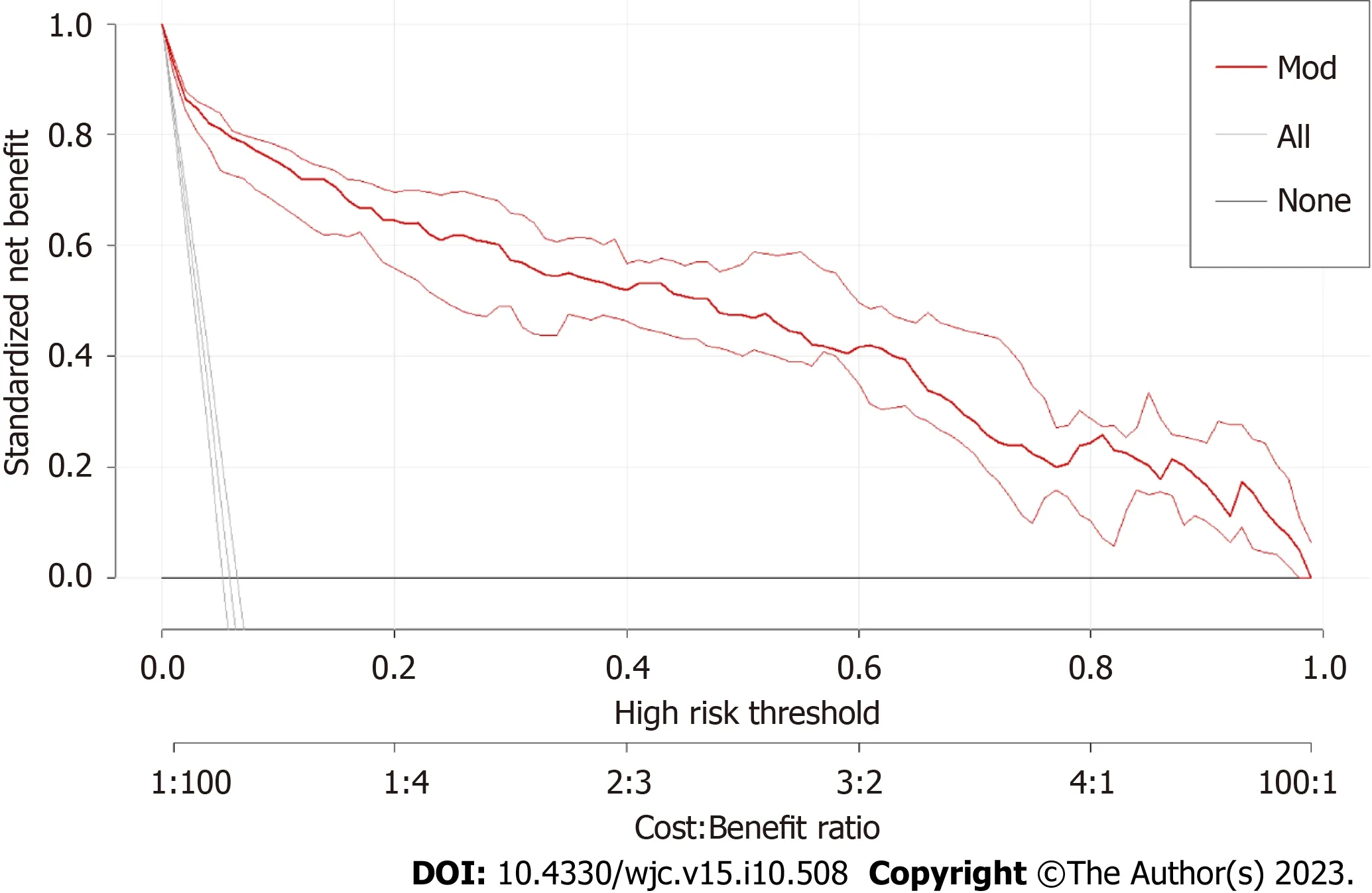Establishment of a prediction model for prehospital return of spontaneous circulation in out-of-hospital patients with cardiac arrest
Jing-Jing Wang,Qiang Zhou,Zhen-Hua Huang,Yong Han,Chong-Zhen Qin,Zhong-Qing Chen,Xiao-Yong Xiao,Zhe Deng
Abstract BACKGROUND Out-of-hospital cardiac arrest (OHCA) is a leading cause of death worldwide.AIM To explore factors influencing prehospital return of spontaneous circulation (PROSC) in patients with OHCA and develop a nomogram prediction model.METHODS Clinical data of patients with OHCA in Shenzhen,China,from January 2012 to December 2019 were retrospectively analyzed.Least absolute shrinkage and selection operator (LASSO) regression and multivariate logistic regression were applied to select the optimal factors predicting P-ROSC in patients with OHCA.A nomogram prediction model was established based on these influencing factors.Discrimination and calibration were assessed using receiver operating characteristic (ROC) and calibration curves.Decision curve analysis (DCA) was used to evaluate the model’s clinical utility.RESULTS Among the included 2685 patients with OHCA,the P-ROSC incidence was 5.8%.LASSO and multivariate logistic regression analyses showed that age,bystander cardiopulmonary resuscitation (CPR),initial rhythm,CPR duration,ventilation mode,and pathogenesis were independent factors influencing P-ROSC in these patients.The area under the ROC was 0.963.The calibration plot demonstrated that the predicted P-ROSC model was concordant with the actual P-ROSC.The good clinical usability of the prediction model was confirmed using DCA.CONCLUSION The nomogram prediction model could effectively predict the probability of P-ROSC in patients with OHCA.
Key Words: Cardiac arrest;Cardiopulmonary resuscitation;Recovery spontaneous circulation;Logistic regression analysis;Predictive model
INTRODUCTION
Out-of-hospital cardiac arrest (OHCA),a leading cause of death worldwide,has an average incidence of (30.0-97.1) cases per 100000 person-years[1],with a survival rate of only 8.8% at hospital discharge[2].In China,550000 people develop OHCA annually[2] with a survival rate of only 1.3% after discharge,making OHCA a major public health issue.The survival rate from hospital discharge of patients with OHCA who have achieved a return of spontaneous circulation(ROSC) to hospital handover is still approximately 10%[3].Moreover,patients with prehospital ROSC (P-ROSC) have better neurological outcomes compared with those who do not.Some areas regions have reported high ROSC rates during hospital handovers,such as 25% in England[4] and 29.1% in Tasmania,Australia[5].In China,however,the PROSC rate was only 6.26% in a recent survey in Beijing[6],demonstrating that a large gap still exists between countries.
Investigations have reported a range of pre-emergency medical service (EMS) intervention factors for patients with OHCA that are associated with P-ROSC,including age,prehospital drug administration,witnessed status,first rhythm,and response time[7].The relative contribution of each of these factors to P-ROSC varies across countries.However,no model including pre-EMS intervention factors and prehospital emergency measures has been developed for ROSC during hospital handovers in China.Therefore,the development of an effective prediction model is required for ROSC during hospital handovers based on pre-EMS intervention factors and prehospital emergency measures.
This study aimed to identify independent factors associated with P-ROSC and develop and evaluate a nomogram model in China to predict whether ROSC can be achieved during the prehospital period in OHCA.
MATERIALS AND METHODS
Study design and setting
A multicenter retrospective study was conducted at the Shenzhen Center for Prehospital Care,which covered all hospitals in Shenzhen;that is,approximately 150 hospitals,from January 2012 to December 2019.All first-aid measures were performed according to the American Heart Association (AHA) Guidelines for cardiopulmonary resuscitation(CPR).
Participants
We retrospectively collected data from emergency medical technicians (EMTs).The inclusion criteria were patients with OHCA aged ≥ 18 years,The exclusion criteria were incomplete cases,dead patients (i.e.,rigor mortis,lividity,decomposition,or decapitation) without CPR by the EMTs,and patients whose family members forwent all treatments.
Data collection
Data were gathered from two sources: The Registration System of Pre-hospital First Aid Information and Statistics and the Patient Care Report Form.The extracted data included clinical features such as sex,age,time of arrest (i.e.,0-8,8-16,or 16-24 min),season of arrest,bystander CPR,initial rhythm,CPR duration,ventilation mode,defibrillation,epinephrine dose,use of other drugs (atropine,lidocaine,and amiodarone),and outcomes (P-ROSC).
According to the 2015 AHA guidelines,ROSC was defined as the clinical indication of the presence of vital signs,including palpable pulses or blood pressure.
Statistical analysis
IBM SPSS Statistics for Windows,version 26.0,and R 3.1.2 were used to perform all analyses.Thet-test and Mann–Whitney U test were used for numerical variables,while the chi-square test was applied to categorical variables.A model was established using least absolute shrinkage and selection operator (LASSO) regression and multivariable backward regression.For the LASSO regression,lambda.min (a minimum mean squared error) and lambda.1se(lambda.min with one standard error) were identified as the goodness penalty lambda based on the lambda-choosing path[8].To screen for potential predictive factors,LASSO regression models with a lambda.1 se penalty were constructed.The variables selectedviaLASSO were included in a multivariate backward regression analysis to identify the independent influencing features of patients with OHCA.A nomogram prediction model was then constructed based on the variables with statistical significance.The discrimination and calibration of the model were assessed using receiver operating characteristic (ROC) and calibration curves,as well as the Hosmer–Lemeshow test.Internal verification was performed by strengthening the bootstrap method for 1000 repetitions,as shown in the calibration curves.The clinical practicability of the model was evaluated using decision curve analysis (DCA) according to the net benefit with different threshold probabilities.
RESULTS
A total of 2685 cases of patients with OHCA satisfied the inclusion and exclusion criteria.Table 1 presents the characteristics of all OHCA incidents in which first-aid treatment was implemented.
Feature selection and model development
We applied LASSO regression to identify potential predictors and then employed multivariate backward logistic regression to establish the model.As shown in Figure 1,the LASSO regression identified seven features through the lambda.1se penalty: Age,bystander CPR,initial rhythm,CPR duration,ventilation mode,use of amiodarone and lidocaine,and etiology.A model was then formed based on the factors evaluated using multivariate logistic regression(Table 2,Figure 3),during which amiodarone was eliminated.

Figure 1 Factor selection of prehospital return of spontaneous circulation via least absolute shrinkage and selection operator regression.A: Least absolute shrinkage and selection operator coefficient profiles of the 17 features.A coefficient profile plot was conducted against the log (lambda,λ)sequence;B: Through 10-fold cross-validation,and the optimal parameter (lambda,λ) selection via the minimum criteria.A partial likelihood deviance (binomial deviance) curve was plotted versus log λ.The dotted vertical line on the right was drawn at lambda.1se and four features were selected.

Figure 2 Nomogram prediction model of prehospital return of spontaneous circulation. Six predictors were included: Age,bystander cardiopulmonary resuscitation (CPR),initial rhythm,CPR duration,ventilation mode,and etiology.Each variable was assigned a score on a point-scale axis.The total score was easily calculated by adding each single score.The probability of prehospital return of spontaneous circulation is estimated by projecting the total score to the lower total-point scale.

Figure 3 Receiver operating characteristic curves of prehospital return of spontaneous circulation model. The area under the receiver operating characteristic curve of the prehospital return of spontaneous circulation prediction model was 0.9627 (95%: 0.9485-0.9769).
Validation of the predictive model
The area under the receiver operating characteristic curve (AUC) of the P-ROSC prediction model was 0.9627 (95%:0.9485-0.9769),which demonstrated the good discrimination ability of the model (Figure 3).A strengthened bootstrap self-sampling method was used to verify the model internally.Furthermore,the calibration plots fitted well with the ideal curves (Figure 4),indicating that the predicted probability was consistent with the actual probability,as suggested by the results of the Hosmer–Lemeshow test (χ2=8.421,df=8,P=0.3935).DCA to evaluate the clinical utility showed a net benefit for the “treat-all” or “treat-none” strategy (Figure 5),which suggested that the model was clinically useful.

Figure 4 Calibration curves of the prehospital return of spontaneous circulation model. The dotted line represents the apparent model,while the solid line is bias-corrected by strengthening bootstrapping.

Figure 5 Decision curve analysis of the prehospital return of spontaneous circulation model. The X-and Y-axes show the threshold probabilities and net benefits,respectively.The solid red line indicates the prehospital return of spontaneous circulation model.The “All” and “None” lines represent interventions for all or none of the patients,respectively.
DISCUSSION
The survival to hospital discharge in patients with OHCA worldwide is only 4.5%[9].P-ROSC is a short-term survival event.However,recent studies have shown that patients who achieve P-ROSC have better neurological outcomes than those who do not[10,11].Therefore,pre-EMS intervention factors and prehospital emergency measures have been analyzed to evaluate whether EMS intervention measures,including drug treatments,are necessary to inform EMT decisions to terminate the rescue following an appropriate determination to terminate resuscitation.
Age is an influencing factor in OHCA outcomes[12],age is considered as an influencing factor of OHCA outcomes.Consistent with the results of previous studies[13],age was significantly associated with ROSC in the adjusted model(OR: 0.98,P<0.001) in the present study.In terms of etiology,cardiovascular system diseases accounted for the largest proportion of patients with OHCA (53.3%) in this study,while OHCA caused by central nervous system diseases had the highest rate of P-ROSC failure,followed by patients with traumas.
In some regions,the number of CPR bystanders has reached 50%,particularly in advanced countries[14].However,although it is increasing annually,the bystander CPR rate remained poor in the current study.Rajanetal[15] suggested that sustained bystander CPR could increase by more than two-fold.In our study,CPR by bystanders increased the chances of ROSC by 2.6-fold (P=0.004) compared with no bystander CPR.
The initial rhythm is another critical factor because timely defibrillation can increase the ROSC rate when a shockable rhythm occurs[16].In the present study,the initial rhythm was also an essential variable of P-ROSC after adjusting for other variables (P<0.001).Moreover,patients with agonal electrocardiography (Ag ECG) characteristics,such as slow ventricular escape and bradycardia,who progressed to OHCA during treatment,had a higher P-ROSC rate,implying that a shorter time of no reflow time could improve prognosis.
Furthermore,CPR duration is a vital factor in predicting OHCA outcomes.Despite advances in CPR,no comprehensive agreement has been reached regarding the duration of CPR and the time for its termination in patients with OHCA.Funadaetal[17] reported that CPR sustained in patients with OHCA >26 min commonly caused ROSC failure.In the present study,the optimal cut-off time was 27.5 min and each additional minute of CPR was related to a 22% decrease in the probability of P-ROSC (OR: 0.78,P<0.001) after adjustment for variable.Moreover,some studies suggested no possibility of ROSC in CPR lasting >30 min,usually accompanied by irreversible damage to the brain[18].Hence,uncertainties in the proper termination rules for CPR in basic and advanced life support care could increase pressure on ambulance transport,competition for medical resources,and risk of exposure to public accidents owing to high-speed transport[19].However,the appropriate resuscitation termination for patients with OHCA remains controversial.Based on the model performance,we found that patients with OHCA and organ function as well as family abandonment of rescue do not require resuscitation times >30 min.Conversely,in terms of OHCA of young adults (such as sudden cardiac deaths and sudden deaths of unknown causes),ECG manifestations of ventricular fibrillation or bradycardia,or a slow ventricular escape,the intensity of continuous resuscitation should be strengthened until the family approves that resuscitation can be terminated,even beyond 30 min of sustained CPR.
Finally,regarding prehospital advanced airway management (AAM) in patients with OHCA[20,21],some studies have shown that endotracheal intubation (ETI) can improve the probability of sustained ROSC,survival to hospital discharge,and neurologic outcomes[22].In the present study,ETI was significantly associated with P-ROSC (OR: 8.28,P<0.001).Moreover,Benoitetal[23] suggested that a delay in ETI was related to worse ROSC outcomes.In addition,Izawaetal[24]confirmed that AAM resulted in better survival in patients with non-shockable rhythms than in those with shockablerhythms,which might indicate the impact of shockable rhythms on the role of ETI in OHCA.Therefore,the effects of ETI in such situations warrant further investigation.
Jietal[4],Morganetal[5],and Navabetal[13] and others have established models in the United Kingdom,Australia,and Iran,respectively,to describe the influencing factors of clinical features and prehospital emergency measures on the ROSC rate as well as the survival rate of patients with OHCA.However,these researchers did not collect data on prehospital drug administration,including the use and dosage of epinephrine or other drugs.We developed a simple model applied to OHCA of all etiologies that covered pre-EMS intervention factors and prehospital emergency measures,including drugs and their dosage,although prehospital drug administration was not included in the model.Liuetal[7]developed a P-ROSC score for patients with OHCA that also collected prehospital drug administration data.However,the model was not appropriate for trauma-induced OHCA,which limited its wide application.Another prospective study that included individuals between 1998 and 2008 generated the RACA score,which is a widely applicable score for ROSC in OHCA.However,it is not a contemporary cohort[25].
Limitations
Due to the retrospective design,the accuracy of data collection and potential confounders could not be assessed,and the identification of specific causalities was limited.Furthermore,incomplete data restricted the research.In addition,we did not collect no-reflow time data because the number of patients with OHCA witnessed by bystanders at the scene was too small.
CONCLUSION
We developed a simple and accessible model to predict the probability of achieving P-ROSC in China.The P-ROSC,with just six factors,is interpretable,convenient to implement,and comprehensive in busy prehospital processing;thus,it could serve as a possible assistive tool for clinical-aid decision-making.
ARTICLE HIGHLIGHTS
Research background
Out-of-hospital cardiac arrest (OHCA) is a leading cause of death worldwide.In China,550000 people develop OHCA annually with a survival rate of only 1.3% after discharge,making OHCA a major public health issue.
Research motivation
A large gap of prehospital return of spontaneous circulation (P-ROSC) rate remains between China and other countries and that the relative contributions of aid measures for each of these factors to P-ROSC vary across countries.There are still not such model,including pre-EMS intervention factors and Prehospital emergency measures,have currently been developed for P-ROSC in China.
Research objectives
To develop a nomogram prediction model which is interpretable,convenient to implement,easy to comprehend in busy prehospital processing,and comprehensive,including prehospital drug administration.Therefore,it could serve as a potentially assistive tool for clinical aid decision-making.
Research methods
Clinical data of patients with OHCA were retrospectively analyzed A nomogram prediction model for P-ROSC in patients with OHCA was developed and validate.
Research results
Among the included 2685 patients with OHCA,the P-ROSC incidence was 5.8%.LASSO and multivariate logistic regression analyses showed that age,bystander cardiopulmonary resuscitation (CPR),initial rhythm,CPR duration,ventilation mode,and pathogenesis were independent factors influencing P-ROSC in these patients.The area under the ROC was 0.963.The calibration plot demonstrated that the predicted P-ROSC model was concordant with the actual PROSC.The good clinical usability of the prediction model was confirmed using decision curve analysis.
Research conclusions
We developed a simple and accessible model to predict the probability of achieving P-ROSC in China.The P-ROSC,with just six factors,is interpretable,convenient to implement,and comprehensive in busy prehospital processing;thus,it could serve as a possible assistive tool for clinical-aid decision-making.
Research perspectives
If we go one step further,we start to conduct prospective studies to identify the specific causalities and to improve the accuracy of data collection.
FOOTNOTES
Co-first authors:Jing-Jing Wang and Qiang Zhou.
Author contributions:Wang JJ,Zhou Q contributed equally to this work and share first authorship;Deng Z,Wang JJ,and Zhou Q designed the research study;Wang JJ and Zhou Q analyzed the data and wrote the manuscript;Deng Z were responsible for revising the manuscript for important intellectual content;Wang JJ,Zhou Q,Huang ZH,Han Y,Qin CZ,Qin CZ,and Xiao XY performed the primary literature and data extraction;All authors read and approved the final version.
Supported byShenzhen Science and Technology Program,No.JCYJ20180228163 014668;Shenzhen Second People’s Hospital Clinical Research Fund of Guangdong Province High-level Hospital Construction Project;No.20223 357005;and No.2023xgyj3357002.
Institutional review board statement:The study was reviewed and approved by the Shenzhen Center for Prehospital Care Institutional Review Board [(No.2023-071-02PJ)].
Informed consent statement:This study meets the conditions for applying for exemption from informed consent in China,and the exemption from informed consent has been approved.
Conflict-of-interest statement:All the authors declare no conflicts of interest for this article.
Data sharing statement:Technical appendix,statistical code,and dataset available from the corresponding author at dengzhe202209@163.com.
Open-Access:This article is an open-access article that was selected by an in-house editor and fully peer-reviewed by external reviewers.It is distributed in accordance with the Creative Commons Attribution NonCommercial (CC BY-NC 4.0) license,which permits others to distribute,remix,adapt,build upon this work non-commercially,and license their derivative works on different terms,provided the original work is properly cited and the use is non-commercial.See: https://creativecommons.org/Licenses/by-nc/4.0/
Country/Territory of origin:China
ORCID number:Zhe Deng 0000-0002-9776-7261.
S-Editor:Liu JH
L-Editor:A
P-Editor:Xu ZH
 World Journal of Cardiology2023年10期
World Journal of Cardiology2023年10期
- World Journal of Cardiology的其它文章
- Candida endocarditis: Update on management considerations
- Systemic right ventricle complications in levo-transposition of the great arteries: A case report and review of literature
- Do cardiopulmonary resuscitation real-time audiovisual feedback devices improve patient outcomes? A systematic review and metaanalysis
- Cardiovascular complications following medical termination of pregnancy: An updated review
- Integrated analysis of comorbidity,pregnant outcomes,and amniotic fluid cytogenetics of fetuses with persistent left superior vena cava
- Value of cardiac magnetic resonance on the risk stratification of cardiomyopathies
